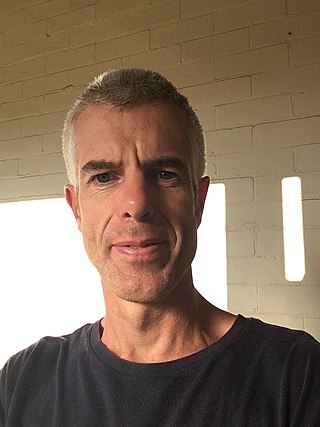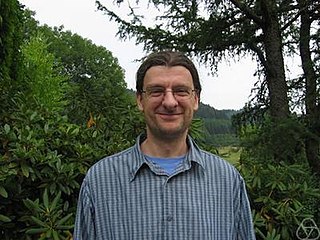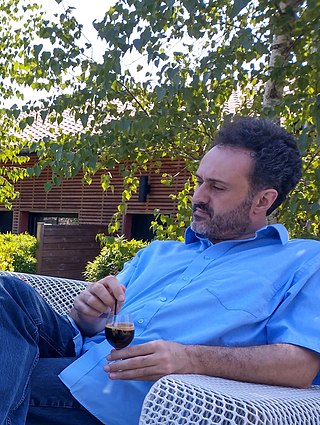Related Research Articles

Algebraic geometry is a branch of mathematics which classically studies zeros of multivariate polynomials. Modern algebraic geometry is based on the use of abstract algebraic techniques, mainly from commutative algebra, for solving geometrical problems about these sets of zeros.
In mathematics a stack or 2-sheaf is, roughly speaking, a sheaf that takes values in categories rather than sets. Stacks are used to formalise some of the main constructions of descent theory, and to construct fine moduli stacks when fine moduli spaces do not exist.
In mathematics, the field with one element is a suggestive name for an object that should behave similarly to a finite field with a single element, if such a field could exist. This object is denoted F1, or, in a French–English pun, Fun. The name "field with one element" and the notation F1 are only suggestive, as there is no field with one element in classical abstract algebra. Instead, F1 refers to the idea that there should be a way to replace sets and operations, the traditional building blocks for abstract algebra, with other, more flexible objects. Many theories of F1 have been proposed, but it is not clear which, if any, of them give F1 all the desired properties. While there is still no field with a single element in these theories, there is a field-like object whose characteristic is one.

Noncommutative algebraic geometry is a branch of mathematics, and more specifically a direction in noncommutative geometry, that studies the geometric properties of formal duals of non-commutative algebraic objects such as rings as well as geometric objects derived from them.

Thomas Andrew Bridgeland is a Professor of Mathematics at the University of Sheffield. He was a senior research fellow in 2011–2013 at All Souls College, Oxford and, since 2013, remains as a Quondam Fellow. He is most well-known for defining Bridgeland stability conditions on triangulated categories.

Aise Johan de Jong is a Dutch mathematician born in Belgium. He currently is a professor of mathematics at Columbia University. His research interests include arithmetic geometry and algebraic geometry.

Kai Behrend is a German mathematician. He is a professor at the University of British Columbia in Vancouver, British Columbia, Canada.
In mathematics, specifically algebraic geometry, Donaldson–Thomas theory is the theory of Donaldson–Thomas invariants. Given a compact moduli space of sheaves on a Calabi–Yau threefold, its Donaldson–Thomas invariant is the virtual number of its points, i.e., the integral of the cohomology class 1 against the virtual fundamental class. The Donaldson–Thomas invariant is a holomorphic analogue of the Casson invariant. The invariants were introduced by Simon Donaldson and Richard Thomas (1998). Donaldson–Thomas invariants have close connections to Gromov–Witten invariants of algebraic three-folds and the theory of stable pairs due to Rahul Pandharipande and Thomas.

Richard Paul Winsley Thomas is a British mathematician working in several areas of geometry. He is a professor at Imperial College London. He studies moduli problems in algebraic geometry, and ‘mirror symmetry’—a phenomenon in pure mathematics predicted by string theory in theoretical physics.
In algebraic geometry, a derived scheme is a pair consisting of a topological space X and a sheaf either of simplicial commutative rings or of commutative ring spectra on X such that (1) the pair is a scheme and (2) is a quasi-coherent -module. The notion gives a homotopy-theoretic generalization of a scheme.
Derived algebraic geometry is a branch of mathematics that generalizes algebraic geometry to a situation where commutative rings, which provide local charts, are replaced by either differential graded algebras, simplicial commutative rings or -ring spectra from algebraic topology, whose higher homotopy groups account for the non-discreteness of the structure sheaf. Grothendieck's scheme theory allows the structure sheaf to carry nilpotent elements. Derived algebraic geometry can be thought of as an extension of this idea, and provides natural settings for intersection theory of singular algebraic varieties and cotangent complexes in deformation theory, among the other applications.
In algebraic geometry, the moduli stack of formal group laws is a stack classifying formal group laws and isomorphisms between them. It is denoted by . It is a "geometric “object" that underlies the chromatic approach to the stable homotopy theory, a branch of algebraic topology.
In algebraic geometry, a toric stack is a stacky generalization of a toric variety. More precisely, a toric stack is obtained by replacing in the construction of a toric variety a step of taking GIT quotients with that of taking quotient stacks. Consequently, a toric variety is a coarse approximation of a toric stack. A toric orbifold is an example of a toric stack.
This is a glossary of properties and concepts in symplectic geometry in mathematics. The terms listed here cover the occurrences of symplectic geometry both in topology as well as in algebraic geometry. The glossary also includes notions from Hamiltonian geometry, Poisson geometry and geometric quantization.
In algebraic geometry, the Chow group of a stack is a generalization of the Chow group of a variety or scheme to stacks. For a quotient stack , the Chow group of X is the same as the G-equivariant Chow group of Y.

Bertrand Toën is a mathematician who works as a director of research at the Centre national de la recherche scientifique (CNRS) at the Paul Sabatier University, Toulouse, France. He received his PhD in 1999 from the Paul Sabatier University, where he was supervised by Carlos Simpson and Joseph Tapia.
In algebra, given a differential graded algebra A over a commutative ring R, the derived tensor product functor is
In algebraic geometry, there are various generalizations of the Riemann–Roch theorem; among the most famous is the Grothendieck–Riemann–Roch theorem, which is further generalized by the formulation due to Fulton et al.
Gabriele Vezzosi is an Italian mathematician, born in Florence (Italy). His main interest is algebraic geometry.
In mathematics, a stacky curve is an object in algebraic geometry that is roughly an algebraic curve with potentially "fractional points" called stacky points. A stacky curve is a type of stack used in studying Gromov–Witten theory, enumerative geometry, and rings of modular forms.
References
- Toën, Bertrand (2014), Derived Algebraic Geometry, arXiv: 1401.1044
- Toën, Bertrand (2006), Higher and derived stacks: a global overview, arXiv: math/0604504
- Lurie, Jacob. "Derived Algebraic Geometry". hdl:1721.1/30144.
- Mathew, Akhil; Meier, Lennart (2013). "Affineness and chromatic homotopy theory". Journal of Topology. 8 (2): 476–528. arXiv: 1311.0514 . doi:10.1112/jtopol/jtv005. S2CID 119713516.